Publications
publications by categories in reversed chronological order. generated by jekyll-scholar.
2025
-
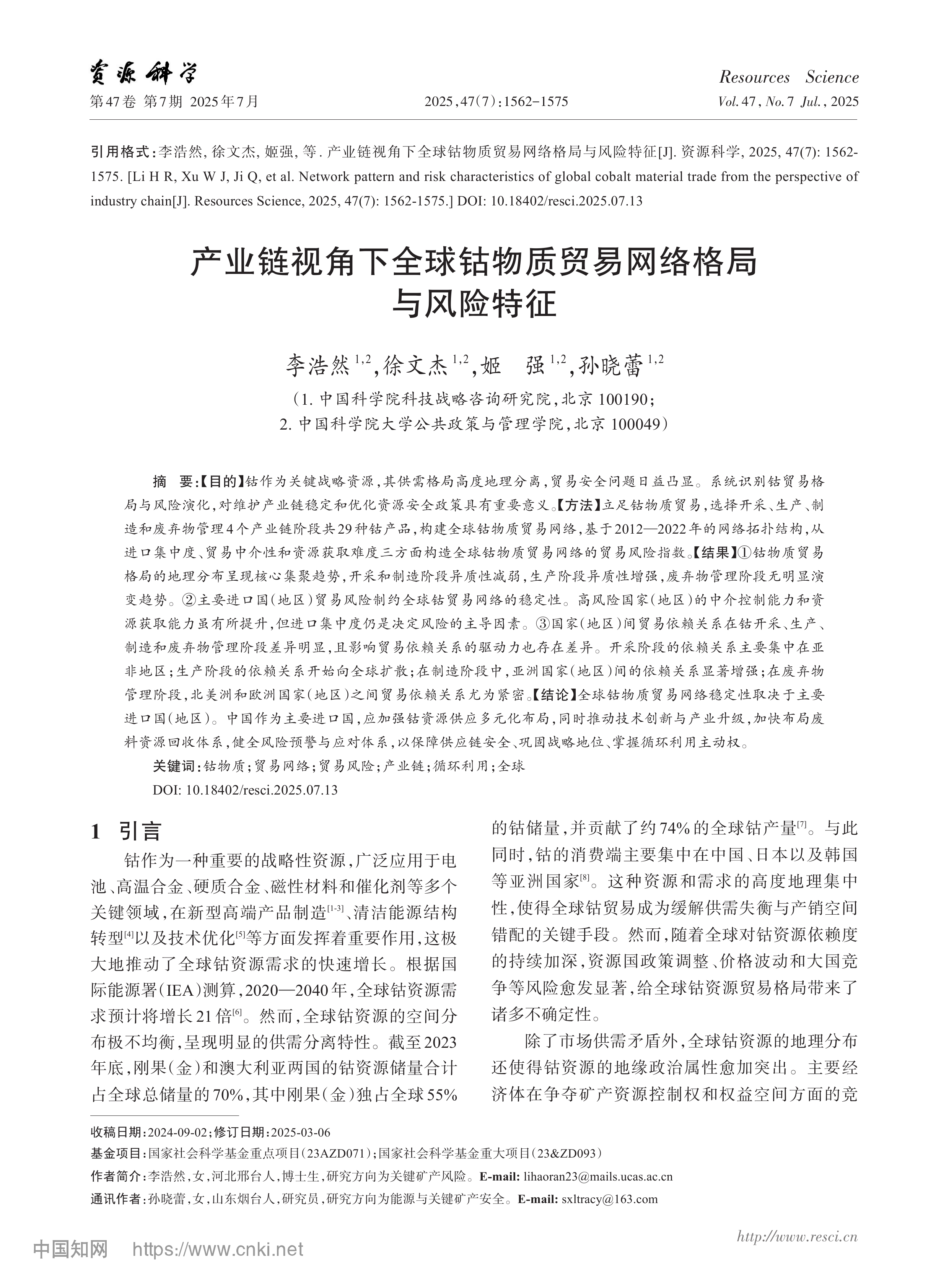 产业链视角下全球钴物质贸易网络格局与风险特征Haoran Li, Wenjie Xu, Qiang Ji, and Xiaolei Sun*资源科学, 2025
产业链视角下全球钴物质贸易网络格局与风险特征Haoran Li, Wenjie Xu, Qiang Ji, and Xiaolei Sun*资源科学, 2025【目的】钴作为关键战略资源,其供需格局高度地理分离,贸易安全问题日益凸显。系统识别钴贸易格局与风险演化,对维护产业链稳定和优化资源安全政策具有重要意义。【方法】立足钴物质贸易,选择开采、生产、制造和废弃物管理4个产业链阶段共29种钴产品,构建全球钴物质贸易网络,基于2012—2022年的网络拓扑结构,从进口集中度、贸易中介性和资源获取难度三方面构造全球钴物质贸易网络的贸易风险指数。【结果】(1)钴物质贸易格局的地理分布呈现核心集聚趋势,开采和制造阶段异质性减弱,生产阶段异质性增强,废弃物管理阶段无明显演变趋势。(2)主要进口国(地区)贸易风险制约全球钴贸易网络的稳定性。高风险国家(地区)的中介控制能力和资源获取能力虽有所提升,但进口集中度仍是决定风险的主导因素。(3)国家(地区)间贸易依赖关系在钴开采、生产、制造和废弃物管理阶段差异明显,且影响贸易依赖关系的驱动力也存在差异。开采阶段的依赖关系主要集中在亚非地区;生产阶段的依赖关系开始向全球扩散;在制造阶段中,亚洲国家(地区)间的依赖关系显著增强;在废弃物管理阶段,北美洲和欧洲国家(地区)之间贸易依赖关系尤为紧密。【结论】全球钴物质贸易网络稳定性取决于主要进口国(地区)。中国作为主要进口国,应加强钴资源供应多元化布局,同时推动技术创新与产业升级,加快布局废料资源回收体系,健全风险预警与应对体系,以保障供应链安全、巩固战略地位、掌握循环利用主动权。
@article{LiHaoRanChanYeLianShiJiaoXiaQuanQiuGuWuZhiMaoYiWangLuoGeJuYuFengXianTeZheng2025, title = {产业链视角下全球钴物质贸易网络格局与风险特征}, author = {Li, Haoran and Xu, Wenjie and Ji, Qiang and Sun, Xiaolei}, year = {2025}, journal = {资源科学}, volume = {47}, number = {7}, pages = {1562--1575}, urldate = {2025-08-20}, langid = {chinese}, dimensions = {true}, gscholar = {true}, } -
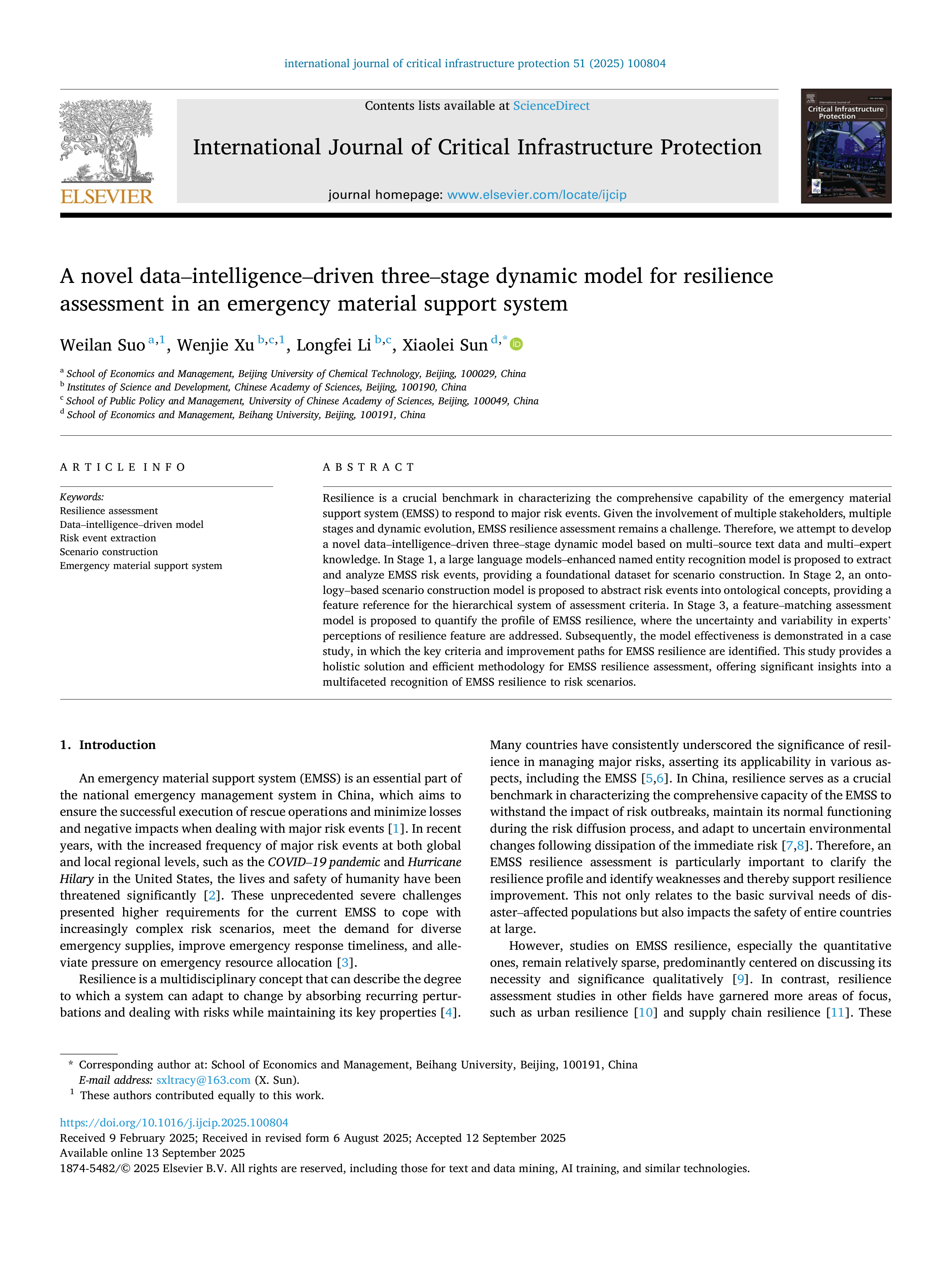 A Novel Data–Intelligence–Driven Three–Stage Dynamic Model for Resilience Assessment in an Emergency Material Support SystemWeilan Suo, Wenjie Xu, Longfei Li, and Xiaolei Sun*International Journal of Critical Infrastructure Protection, Dec 2025
A Novel Data–Intelligence–Driven Three–Stage Dynamic Model for Resilience Assessment in an Emergency Material Support SystemWeilan Suo, Wenjie Xu, Longfei Li, and Xiaolei Sun*International Journal of Critical Infrastructure Protection, Dec 2025Resilience is a crucial benchmark in characterizing the comprehensive capability of the emergency material support system (EMSS) to respond to major risk events. Given the involvement of multiple stakeholders, multiple stages and dynamic evolution, EMSS resilience assessment remains a challenge. Therefore, we attempt to develop a novel data–intelligence–driven three–stage dynamic model based on multi–source text data and multi–expert knowledge. In Stage 1, a large language models–enhanced named entity recognition model is proposed to extract and analyze EMSS risk events, providing a foundational dataset for scenario construction. In Stage 2, an ontology–based scenario construction model is proposed to abstract risk events into ontological concepts, providing a feature reference for the hierarchical system of assessment criteria. In Stage 3, a feature–matching assessment model is proposed to quantify the profile of EMSS resilience, where the uncertainty and variability in experts’ perceptions of resilience feature are addressed. Subsequently, the model effectiveness is demonstrated in a case study, in which the key criteria and improvement paths for EMSS resilience are identified. This study provides a holistic solution and efficient methodology for EMSS resilience assessment, offering significant insights into a multifaceted recognition of EMSS resilience to risk scenarios.
@article{suoNovelDataIntelligence2025, title = {A Novel Data–Intelligence–Driven Three–Stage Dynamic Model for Resilience Assessment in an Emergency Material Support System}, author = {Suo, Weilan and Xu, Wenjie and Li, Longfei and Sun, Xiaolei}, year = {2025}, month = dec, journal = {International Journal of Critical Infrastructure Protection}, volume = {51}, pages = {100804}, issn = {1874-5482}, urldate = {2025-09-17}, langid = {english}, dimensions = {true}, gscholar = {true}, }
2024
-
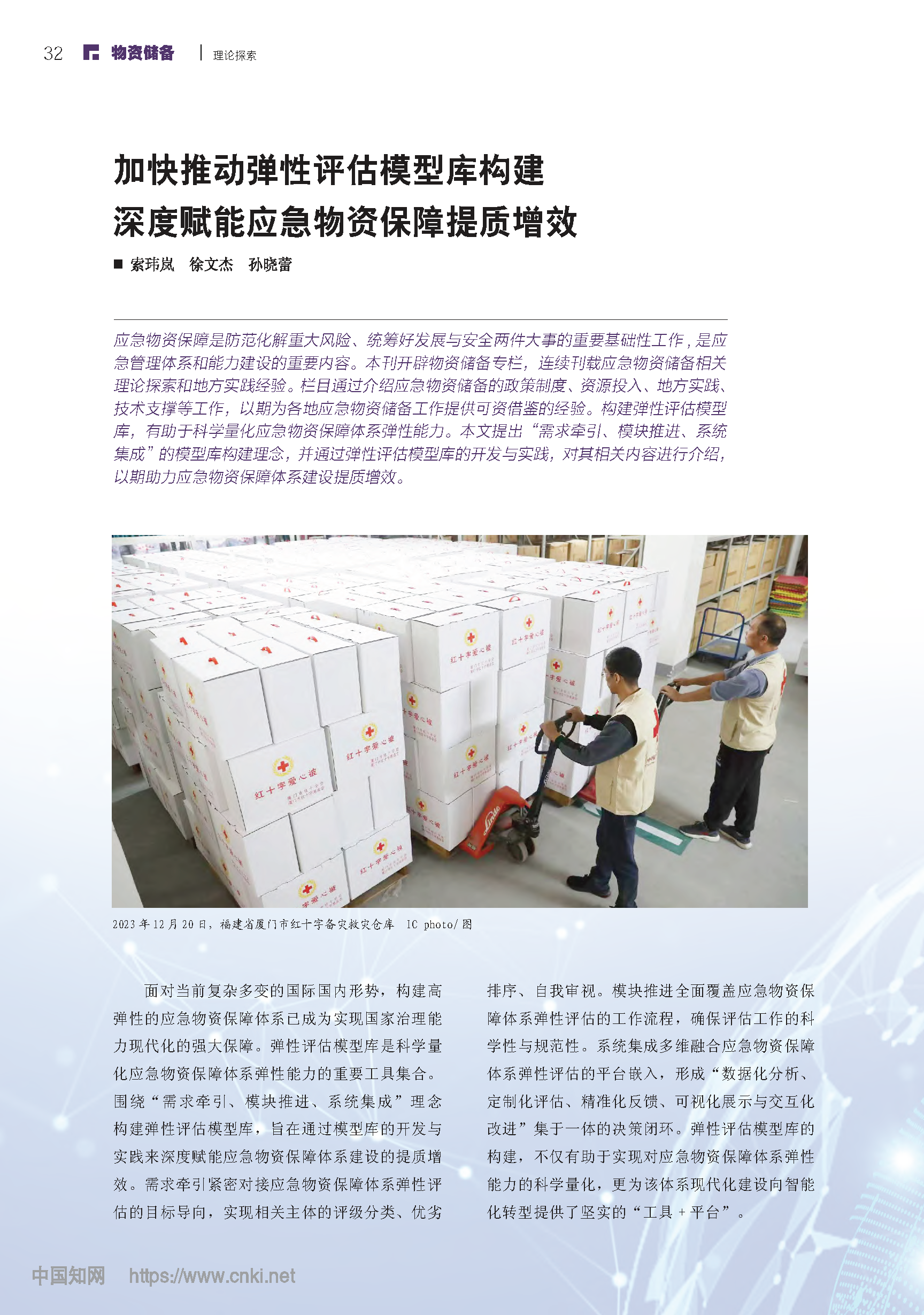 加快推动弹性评估模型库构建 深度赋能应急物资保障提质增效Weilan Suo, Wenjie Xu, and Xiaolei Sun中国减灾, Dec 2024
加快推动弹性评估模型库构建 深度赋能应急物资保障提质增效Weilan Suo, Wenjie Xu, and Xiaolei Sun中国减灾, Dec 2024应急物资保障是防范化解重大风险、统筹好发展与安全两件大事的重要基础性工作,是应急管理体系和能力建设的重要内容。本刊开辟物资储备专栏,连续刊载应急物资储备相关理论探索和地方实践经验。栏目通过介绍应急物资储备的政策制度、资源投入、地方实践、技术支撑等工作,以期为各地应急物资储备工作提供可资借鉴的经验。构建弹性评估模型库,有助于科学量化应急物资保障体系弹性能力。本文提出“需求牵引、模块推进、系统集成”的模型库构建理念,并通过弹性评估模型库的开发与实践,对其相关内容进行介绍,以期助力应急物资保障体系建设提质增效。
@article{SuoWeiLanJiaKuaiTuiDongDanXingPingGuMoXingKuGouJianShenDuFuNengYingJiWuZiBaoZhangTiZhiZengXiao2024, title = {加快推动弹性评估模型库构建 深度赋能应急物资保障提质增效}, author = {Suo, Weilan and Xu, Wenjie and Sun, Xiaolei}, year = {2024}, month = dec, journal = {中国减灾}, number = {23}, pages = {32--33}, issn = {1002-4549}, langid = {chinese}, dimensions = {true}, gscholar = {true}, } -
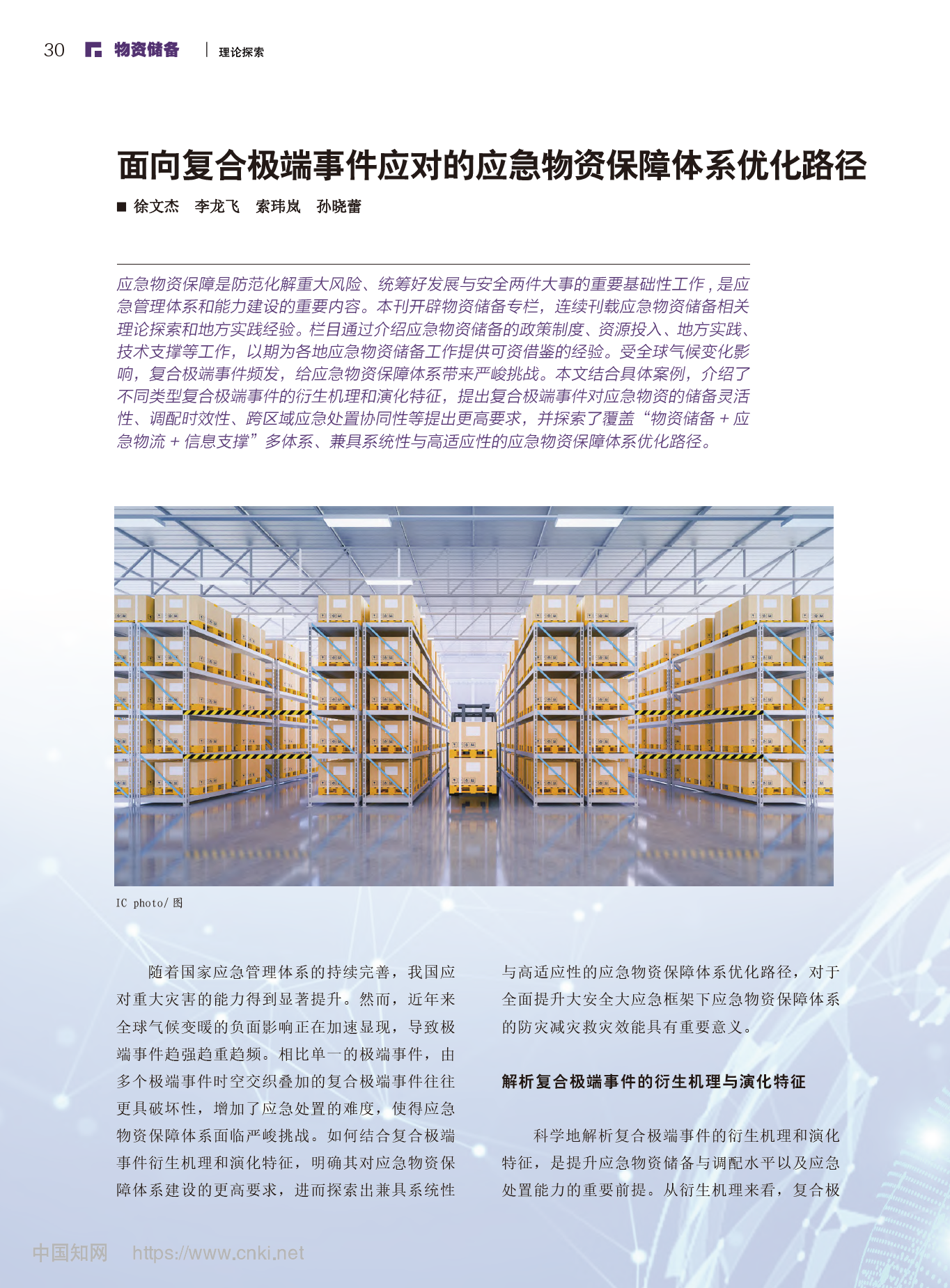 面向复合极端事件应对的应急物资保障体系优化路径Wenjie Xu, Longfei Li, Weilan Suo, and Xiaolei Sun中国减灾, Dec 2024
面向复合极端事件应对的应急物资保障体系优化路径Wenjie Xu, Longfei Li, Weilan Suo, and Xiaolei Sun中国减灾, Dec 2024应急物资保障是防范化解重大风险、统筹好发展与安全两件大事的重要基础性工作,是应急管理体系和能力建设的重要内容。本刊开辟物资储备专栏,连续刊载应急物资储备相关理论探索和地方实践经验。栏目通过介绍应急物资储备的政策制度、资源投入、地方实践、技术支撑等工作,以期为各地应急物资储备工作提供可资借鉴的经验。受全球气候变化影响,复合极端事件频发,给应急物资保障体系带来严峻挑战。本文结合具体案例,介绍了不同类型复合极端事件的衍生机理和演化特征,提出复合极端事件对应急物资的储备灵活性、调配时效性、跨区域应急处置协同性等提出更高要求,并探索了覆盖“物资储备+应急物流+信息支撑”多体系、兼具系统性与高适应性的应急物资保障体系优化路径。
@article{XuWenJieMianXiangFuHeJiDuanShiJianYingDuiDeYingJiWuZiBaoZhangTiXiYouHuaLuJing2024, title = {面向复合极端事件应对的应急物资保障体系优化路径}, author = {Xu, Wenjie and Li, Longfei and Suo, Weilan and Sun, Xiaolei}, year = {2024}, month = dec, date = {2024}, journal = {中国减灾}, number = {21}, pages = {30--33}, issn = {1002-4549}, langid = {chinese}, dimensions = {true}, gscholar = {true}, } -
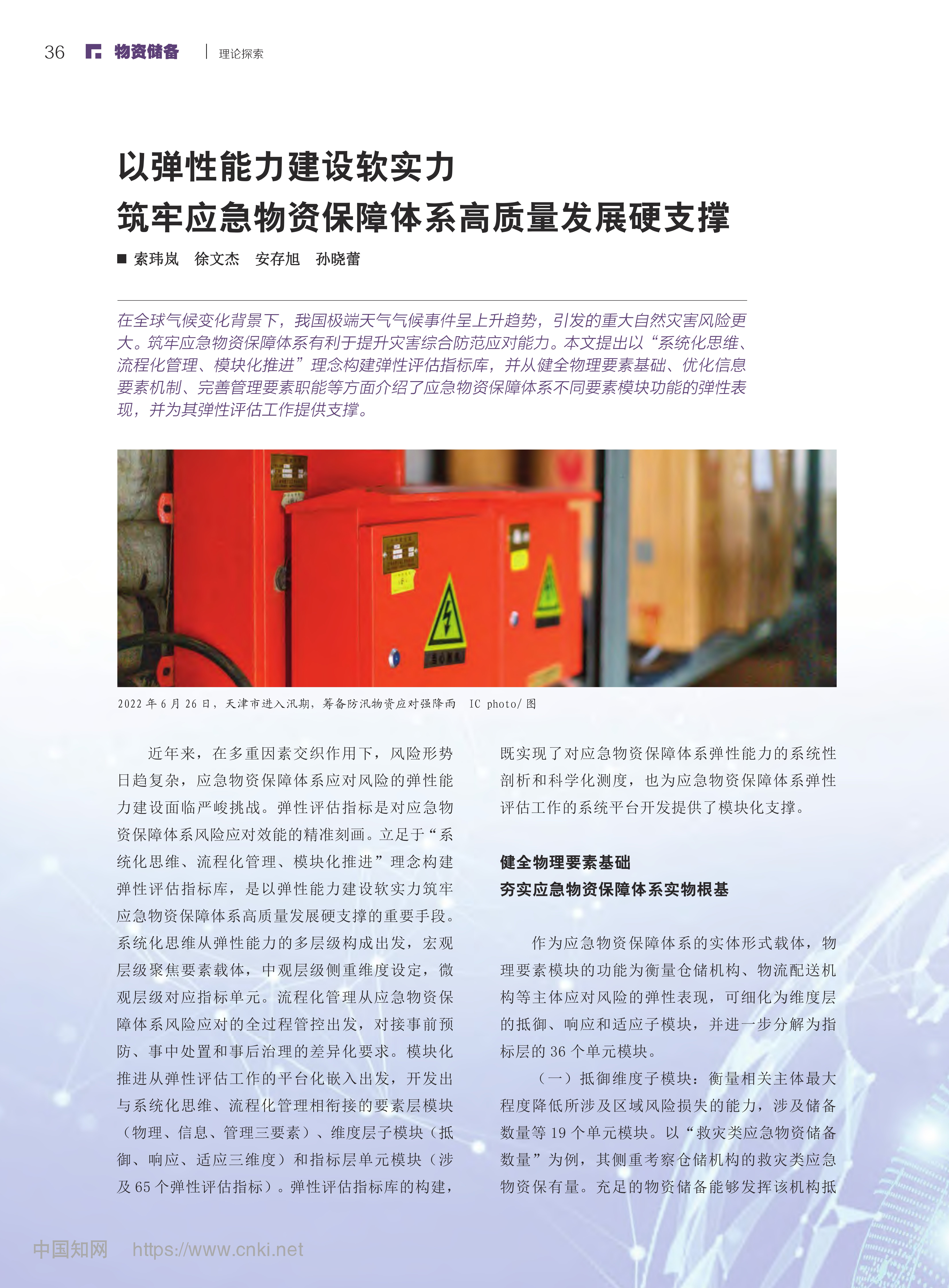 以弹性能力建设软实力 筑牢应急物资保障体系高质量发展硬支撑Weilan Suo, Wenjie Xu, Cunxu An, and Xiaolei Sun中国减灾, Nov 2024
以弹性能力建设软实力 筑牢应急物资保障体系高质量发展硬支撑Weilan Suo, Wenjie Xu, Cunxu An, and Xiaolei Sun中国减灾, Nov 2024在全球气候变化背景下,我国极端天气气候事件呈上升趋势,引发的重大自然灾害风险更大。筑牢应急物资保障体系有利于提升灾害综合防范应对能力。本文提出以“系统化思维、流程化管理、模块化推进”理念构建弹性评估指标库,并从健全物理要素基础、优化信息要素机制、完善管理要素职能等方面介绍了应急物资保障体系不同要素模块功能的弹性表现,并为其弹性评估工作提供支撑。
@article{SuoWeiLanYiDanXingNengLiJianSheRuanShiLiZhuLaoYingJiWuZiBaoZhangTiXiGaoZhiLiangFaZhanYingZhiCheng2024, title = {以弹性能力建设软实力 筑牢应急物资保障体系高质量发展硬支撑}, author = {Suo, Weilan and Xu, Wenjie and An, Cunxu and Sun, Xiaolei}, year = {2024}, month = nov, journal = {中国减灾}, number = {19}, pages = {36--37}, issn = {1002-4549}, langid = {chinese}, } -
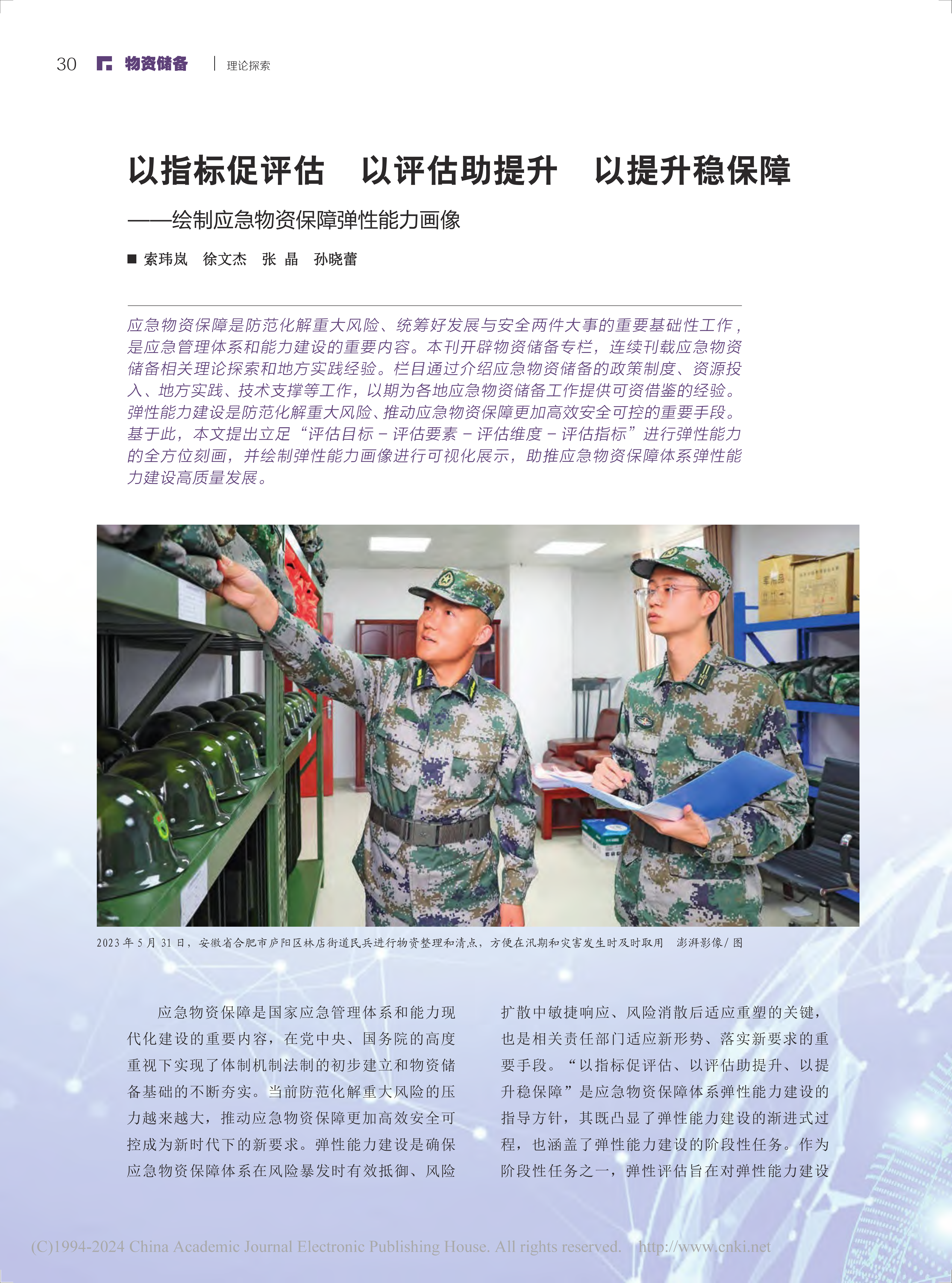 以指标促评估 以评估助提升 以提升稳保障绘制应急物资保障弹性能力画像Weilan Suo, Wenjie Xu, Jing Zhang, and Xiaolei Sun中国减灾, May 2024
以指标促评估 以评估助提升 以提升稳保障绘制应急物资保障弹性能力画像Weilan Suo, Wenjie Xu, Jing Zhang, and Xiaolei Sun中国减灾, May 2024应急物资保障是防范化解重大风险、统筹好发展与安全两件大事的重要基础性工作,是应急管理体系和能力建设的重要内容.本刊开辟物资储备专栏,连续刊载应急物资储备相关理论探索和地方实践经验.栏目通过介绍应急物资储备的政策制度、资源投入、地方实践、技术支撑等工作,以期为各地应急物资储备工作提供可资借鉴的经验.
@article{SuoWeiLanYiZhiBiaoCuPingGuYiPingGuZhuTiShengYiTiShengWenBaoZhang2024, title = {以指标促评估 以评估助提升 以提升稳保障------绘制应急物资保障弹性能力画像}, author = {Suo, Weilan and Xu, Wenjie and Zhang, Jing and Sun, Xiaolei}, year = {2024}, month = may, journal = {中国减灾}, number = {7}, pages = {30--33}, issn = {1002-4549}, urldate = {2024-05-17}, langid = {chinese}, dimensions = {true}, gscholar = {true}, }
2023
-
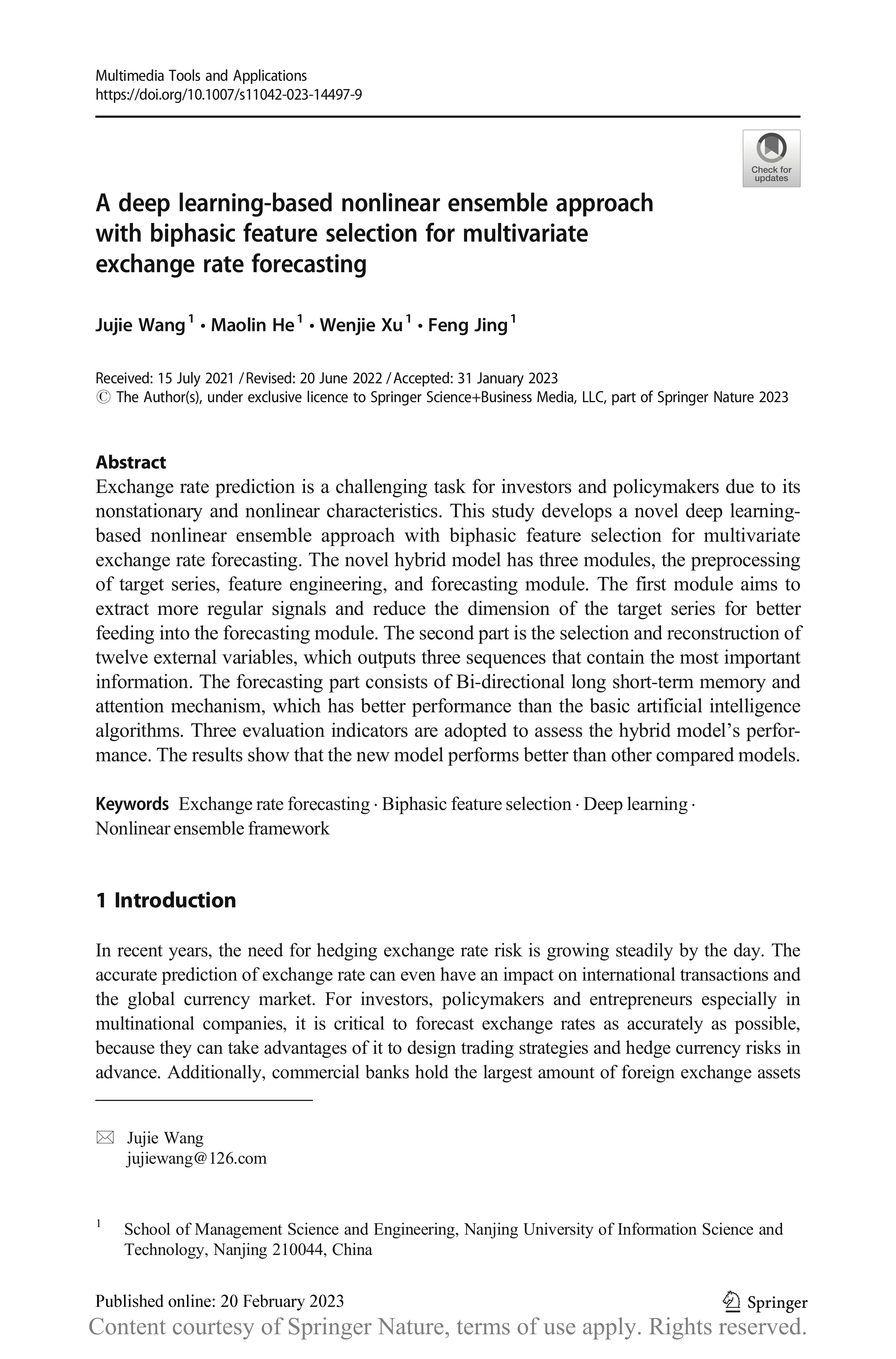 A Deep Learning-Based Nonlinear Ensemble Approach with Biphasic Feature Selection for Multivariate Exchange Rate ForecastingJujie Wang*, Maolin He, Wenjie Xu, and Feng JingMultimedia Tools and Applications, Feb 2023
A Deep Learning-Based Nonlinear Ensemble Approach with Biphasic Feature Selection for Multivariate Exchange Rate ForecastingJujie Wang*, Maolin He, Wenjie Xu, and Feng JingMultimedia Tools and Applications, Feb 2023Exchange rate prediction is a challenging task for investors and policymakers due to its nonstationary and nonlinear characteristics. This study develops a novel deep learningbased nonlinear ensemble approach with biphasic feature selection for multivariate exchange rate forecasting. The novel hybrid model has three modules, the preprocessing of target series, feature engineering, and forecasting module. The first module aims to extract more regular signals and reduce the dimension of the target series for better feeding into the forecasting module. The second part is the selection and reconstruction of twelve external variables, which outputs three sequences that contain the most important information. The forecasting part consists of Bi-directional long short-term memory and attention mechanism, which has better performance than the basic artificial intelligence algorithms. Three evaluation indicators are adopted to assess the hybrid model’s performance. The results show that the new model performs better than other compared models.
@article{wangDeepLearningbasedNonlinear2023, title = {A Deep Learning-Based Nonlinear Ensemble Approach with Biphasic Feature Selection for Multivariate Exchange Rate Forecasting}, author = {Wang, Jujie and He, Maolin and Xu, Wenjie and Jing, Feng}, year = {2023}, month = feb, journal = {Multimedia Tools and Applications}, volume = {82}, number = {15}, pages = {22961--22979}, issn = {1380-7501, 1573-7721}, doi = {10.1007/s11042-023-14497-9}, urldate = {2023-02-25}, langid = {english}, dimensions = {true}, gscholar = {true}, } -
 Resilience Assessment for the Emergency Supplies Security System Based on a Matter-Element Extension MethodWenjie Xu, Jing Zhang, and Weilan Suo*Procedia Computer Science, Feb 2023
Resilience Assessment for the Emergency Supplies Security System Based on a Matter-Element Extension MethodWenjie Xu, Jing Zhang, and Weilan Suo*Procedia Computer Science, Feb 2023The emergency supplies security system (ESSS) plays a vital role in preventing major disasters and ensuring people’s safety. Resilience is an important benchmark to characterize the ability of disaster resistance of the ESSS. However, the ESSS complexity and resilience dynamic evolution make ESSS resilience assessment challenging. This study develops a hierarchical ESSS resilience assessment system comprising three dimensions and twelve criteria, and proposes a dynamic resilience assessment model based on a matter-element extension method. Subsequently, a case study is conducted to demonstrate the applicability of the proposed model. The assessment results indicate that the ESSS resilience in the sample cities has improved over the past five years. However, there are still some shortcomings such as low response rates and high operating costs. This study provides a valuable criteria reference and effective model support for ESSS resilience assessment, which is beneficial for decision makers to clarify the resilience profile, identify the weakness and promote resilience improvement.
@article{xuResilienceAssessmentEmergency2023, title = {Resilience Assessment for the Emergency Supplies Security System Based on a Matter-Element Extension Method}, shorttitle = {基于物元可拓方法的应急物资保障系统弹性评估}, author = {Xu, Wenjie and Zhang, Jing and Suo, Weilan}, year = {2023}, journal = {Procedia Computer Science}, volume = {221}, pages = {741--746}, issn = {18770509}, doi = {10.1016/j.procs.2023.08.046}, langid = {english}, dimensions = {true}, gscholar = {true}, }
2022
-
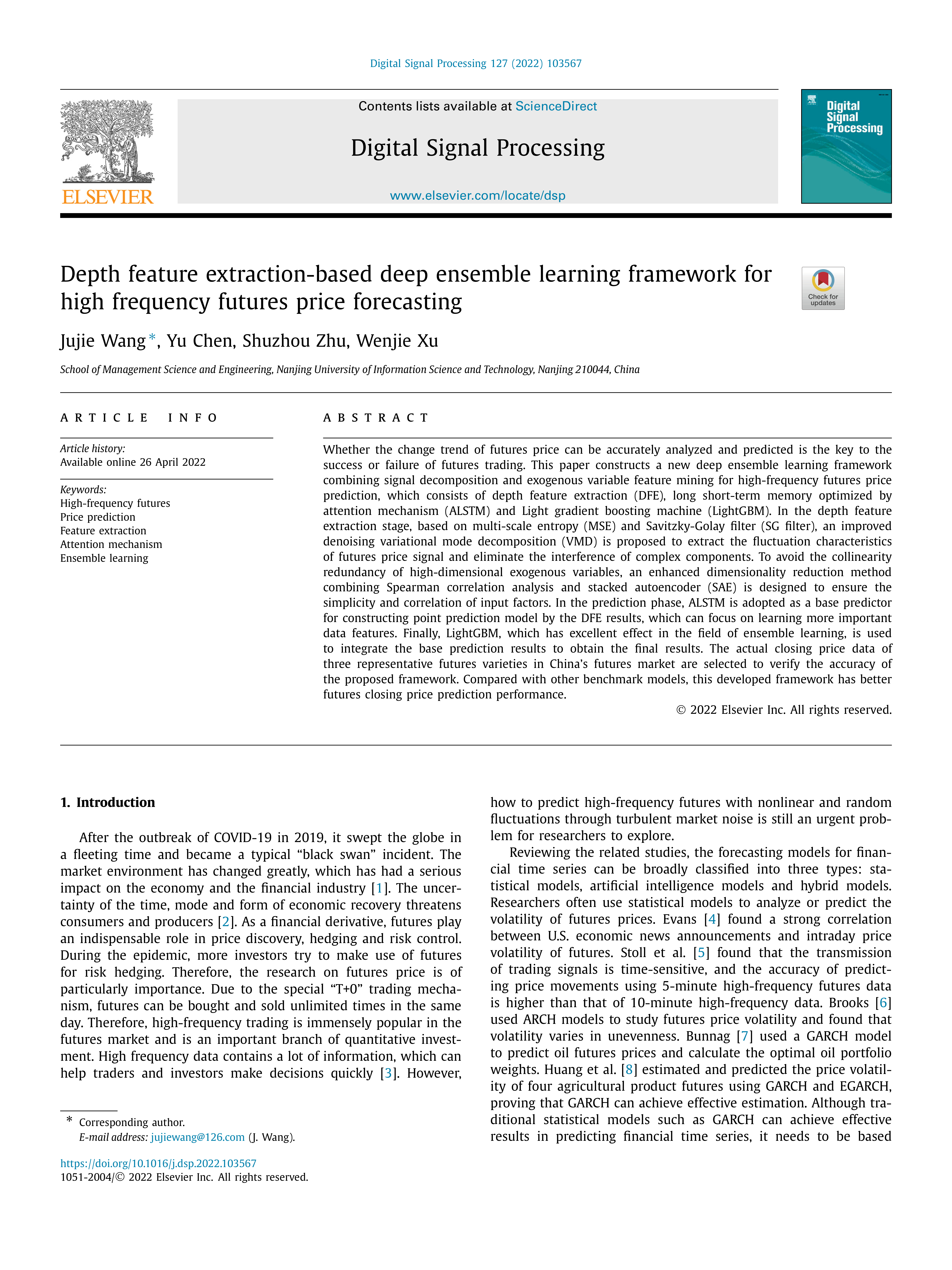 Depth Feature Extraction-Based Deep Ensemble Learning Framework for High Frequency Futures Price ForecastingJujie Wang*, Yu Chen, Shuzhou Zhu, and Wenjie XuDigital Signal Processing, Apr 2022
Depth Feature Extraction-Based Deep Ensemble Learning Framework for High Frequency Futures Price ForecastingJujie Wang*, Yu Chen, Shuzhou Zhu, and Wenjie XuDigital Signal Processing, Apr 2022Whether the change trend of futures price can be accurately analyzed and predicted is the key to the success or failure of futures trading. This paper constructs a new deep ensemble learning framework combining signal decomposition and exogenous variable feature mining for high-frequency futures price prediction, which consists of depth feature extraction (DFE), long short-term memory optimized by attention mechanism (ALSTM) and Light gradient boosting machine (LightGBM). In the depth feature extraction stage, based on multi-scale entropy (MSE) and Savitzky-Golay filter (SG filter), an improved denoising variational mode decomposition (VMD) is proposed to extract the fluctuation characteristics of futures price signal and eliminate the interference of complex components. To avoid the collinearity redundancy of high-dimensional exogenous variables, an enhanced dimensionality reduction method combining Spearman correlation analysis and stacked autoencoder (SAE) is designed to ensure the simplicity and correlation of input factors. In the prediction phase, ALSTM is adopted as a base predictor for constructing point prediction model by the DFE results, which can focus on learning more important data features. Finally, LightGBM, which has excellent effect in the field of ensemble learning, is used to integrate the base prediction results to obtain the final results. The actual closing price data of three representative futures varieties in China’s futures market are selected to verify the accuracy of the proposed framework. Compared with other benchmark models, this developed framework has better futures closing price prediction performance.
@article{wangDepthFeatureExtractionbased2022, title = {Depth Feature Extraction-Based Deep Ensemble Learning Framework for High Frequency Futures Price Forecasting}, author = {Wang, Jujie and Chen, Yu and Zhu, Shuzhou and Xu, Wenjie}, year = {2022}, month = apr, journal = {Digital Signal Processing}, volume = {127}, pages = {103567}, issn = {10512004}, doi = {10.1016/j.dsp.2022.103567}, urldate = {2022-06-26}, langid = {english}, dimensions = {true}, gscholar = {true}, } -
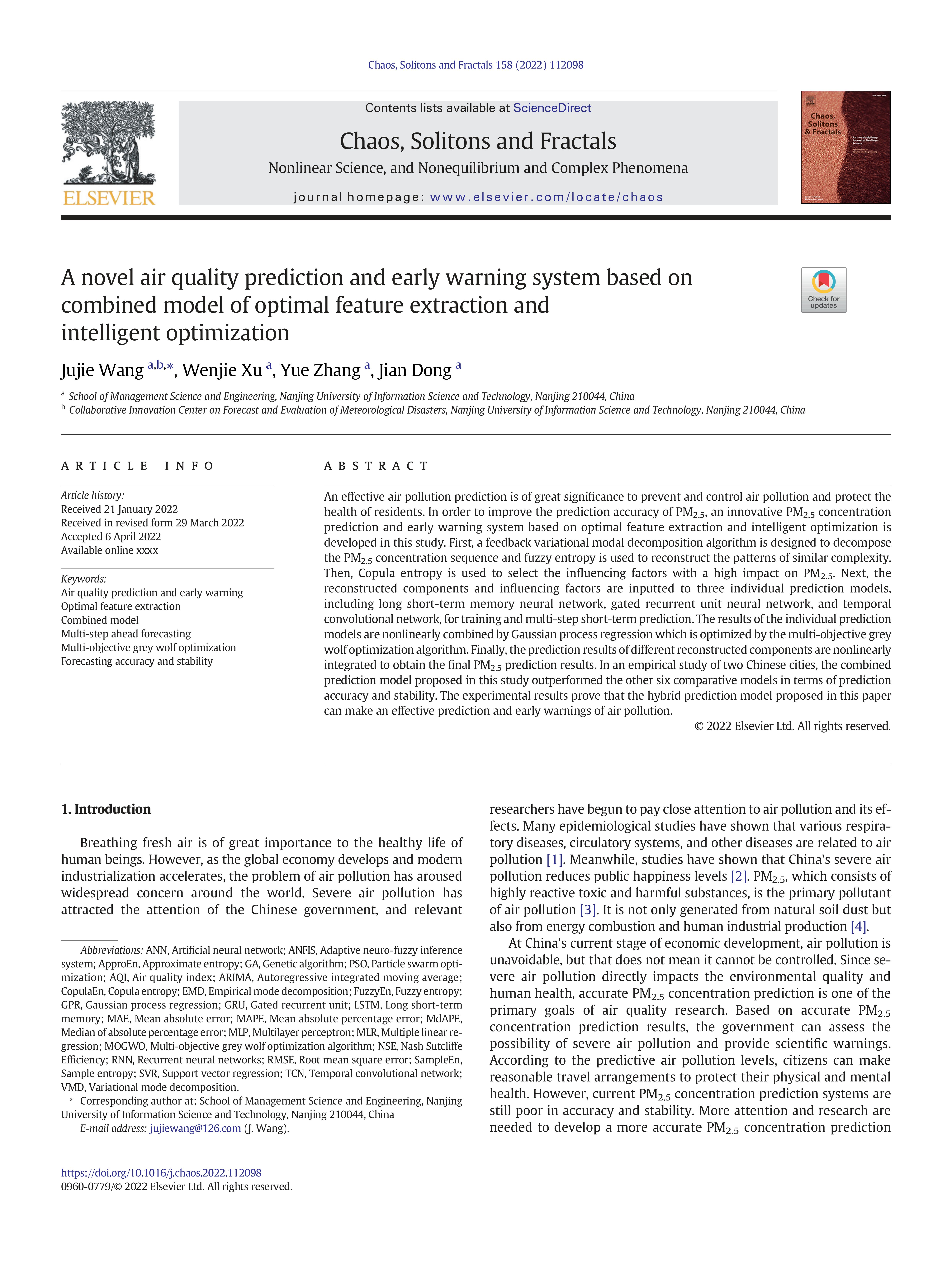 A Novel Air Quality Prediction and Early Warning System Based on Combined Model of Optimal Feature Extraction and Intelligent OptimizationJujie Wang*, Wenjie Xu, Yue Zhang, and Jian DongChaos, Solitons & Fractals, Apr 2022
A Novel Air Quality Prediction and Early Warning System Based on Combined Model of Optimal Feature Extraction and Intelligent OptimizationJujie Wang*, Wenjie Xu, Yue Zhang, and Jian DongChaos, Solitons & Fractals, Apr 2022An effective air pollution prediction is of great significance to prevent and control air pollution and protect the health of residents. In order to improve the prediction accuracy of PM2.5, an innovative PM2.5 concentration prediction and early warning system based on optimal feature extraction and intelligent optimization is developed in this study. First, a feedback variational modal decomposition algorithm is designed to decompose the PM2.5 concentration sequence and fuzzy entropy is used to reconstruct the patterns of similar complexity. Then, Copula entropy is used to select the influencing factors with a high impact on PM2.5. Next, the reconstructed components and influencing factors are inputted to three individual prediction models, including long short-term memory neural network, gated recurrent unit neural network, and temporal convolutional network, for training and multi-step short-term prediction. The results of the individual prediction models are nonlinearly combined by Gaussian process regression which is optimized by the multi-objective grey wolf optimization algorithm. Finally, the prediction results of different reconstructed components are nonlinearly integrated to obtain the final PM2.5 prediction results. In an empirical study of two Chinese cities, the combined prediction model proposed in this study outperformed the other six comparative models in terms of prediction accuracy and stability. The experimental results prove that the hybrid prediction model proposed in this paper can make an effective prediction and early warnings of air pollution.
@article{wangNovelAirQuality2022, title = {A Novel Air Quality Prediction and Early Warning System Based on Combined Model of Optimal Feature Extraction and Intelligent Optimization}, author = {Wang, Jujie and Xu, Wenjie and Zhang, Yue and Dong, Jian}, year = {2022}, month = apr, journal = {Chaos, Solitons \& Fractals}, volume = {158}, pages = {112098}, issn = {09600779}, doi = {10.1016/j.chaos.2022.112098}, langid = {english}, dimensions = {true}, gscholar = {true}, } -
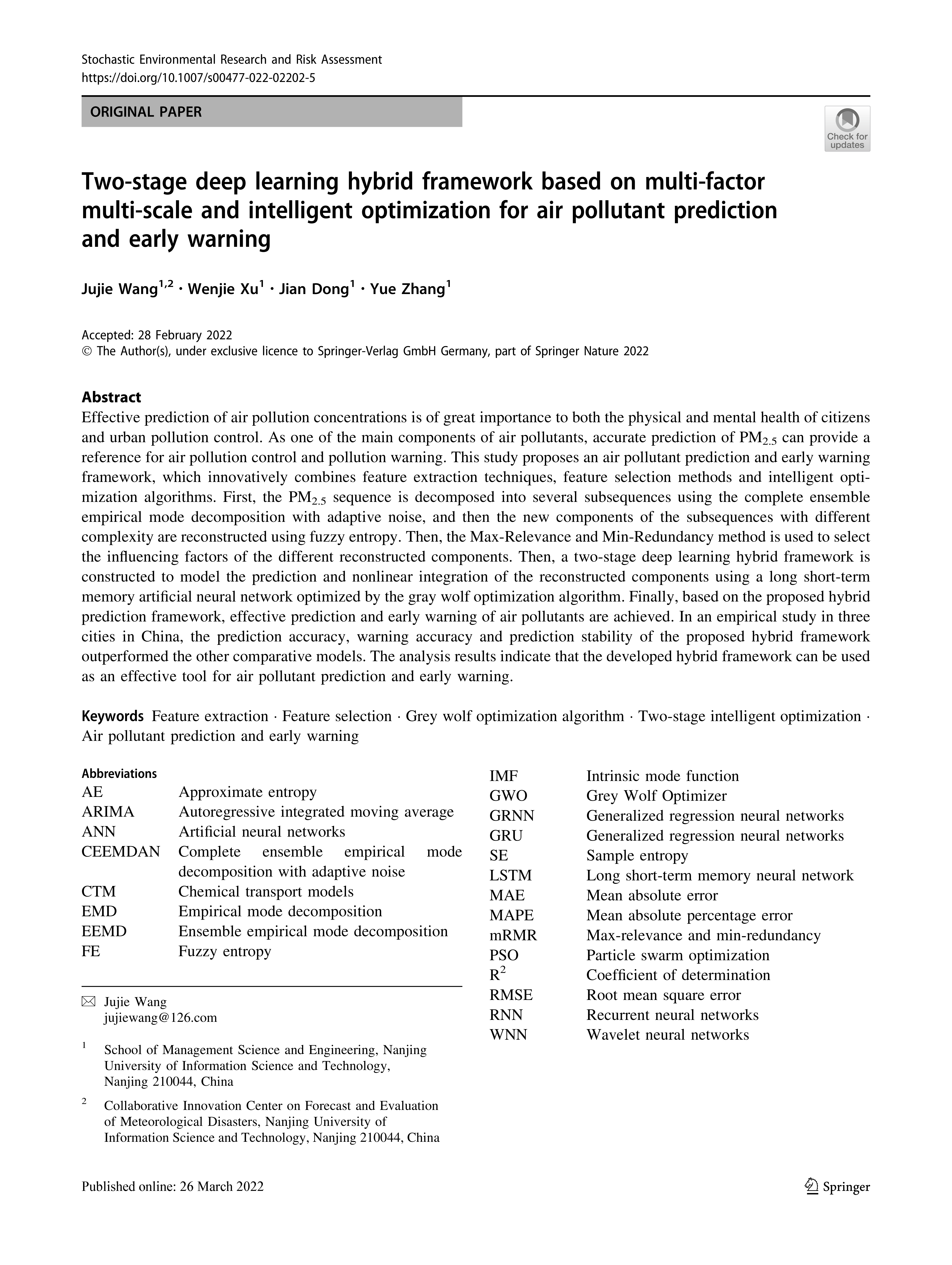 Two-Stage Deep Learning Hybrid Framework Based on Multi-Factor Multi-Scale and Intelligent Optimization for Air Pollutant Prediction and Early WarningJujie Wang*, Wenjie Xu, Jian Dong, and Yue ZhangStochastic Environmental Research and Risk Assessment, Mar 2022
Two-Stage Deep Learning Hybrid Framework Based on Multi-Factor Multi-Scale and Intelligent Optimization for Air Pollutant Prediction and Early WarningJujie Wang*, Wenjie Xu, Jian Dong, and Yue ZhangStochastic Environmental Research and Risk Assessment, Mar 2022Effective prediction of air pollution concentrations is of great importance to both the physical and mental health of citizens and urban pollution control. As one of the main components of air pollutants, accurate prediction of PM2.5 can provide a reference for air pollution control and pollution warning. This study proposes an air pollutant prediction and early warning framework, which innovatively combines feature extraction techniques, feature selection methods and intelligent optimization algorithms. First, the PM2.5 sequence is decomposed into several subsequences using the complete ensemble empirical mode decomposition with adaptive noise, and then the new components of the subsequences with different complexity are reconstructed using fuzzy entropy. Then, the Max-Relevance and Min-Redundancy method is used to select the influencing factors of the different reconstructed components. Then, a two-stage deep learning hybrid framework is constructed to model the prediction and nonlinear integration of the reconstructed components using a long short-term memory artificial neural network optimized by the gray wolf optimization algorithm. Finally, based on the proposed hybrid prediction framework, effective prediction and early warning of air pollutants are achieved. In an empirical study in three cities in China, the prediction accuracy, warning accuracy and prediction stability of the proposed hybrid framework outperformed the other comparative models. The analysis results indicate that the developed hybrid framework can be used as an effective tool for air pollutant prediction and early warning.
@article{wangTwostageDeepLearning2022, title = {Two-Stage Deep Learning Hybrid Framework Based on Multi-Factor Multi-Scale and Intelligent Optimization for Air Pollutant Prediction and Early Warning}, shorttitle = {基于多因子多尺度智能优化的两阶段深度学习混合框架 在大气污染物预测预警中的应用}, author = {Wang, Jujie and Xu, Wenjie and Dong, Jian and Zhang, Yue}, year = {2022}, month = mar, journal = {Stochastic Environmental Research and Risk Assessment}, volume = {36}, number = {10}, pages = {3417--3437}, issn = {1436-3240, 1436-3259}, doi = {10.1007/s00477-022-02202-5}, copyright = {All rights reserved}, langid = {english}, dimensions = {true}, gscholar = {true}, } -
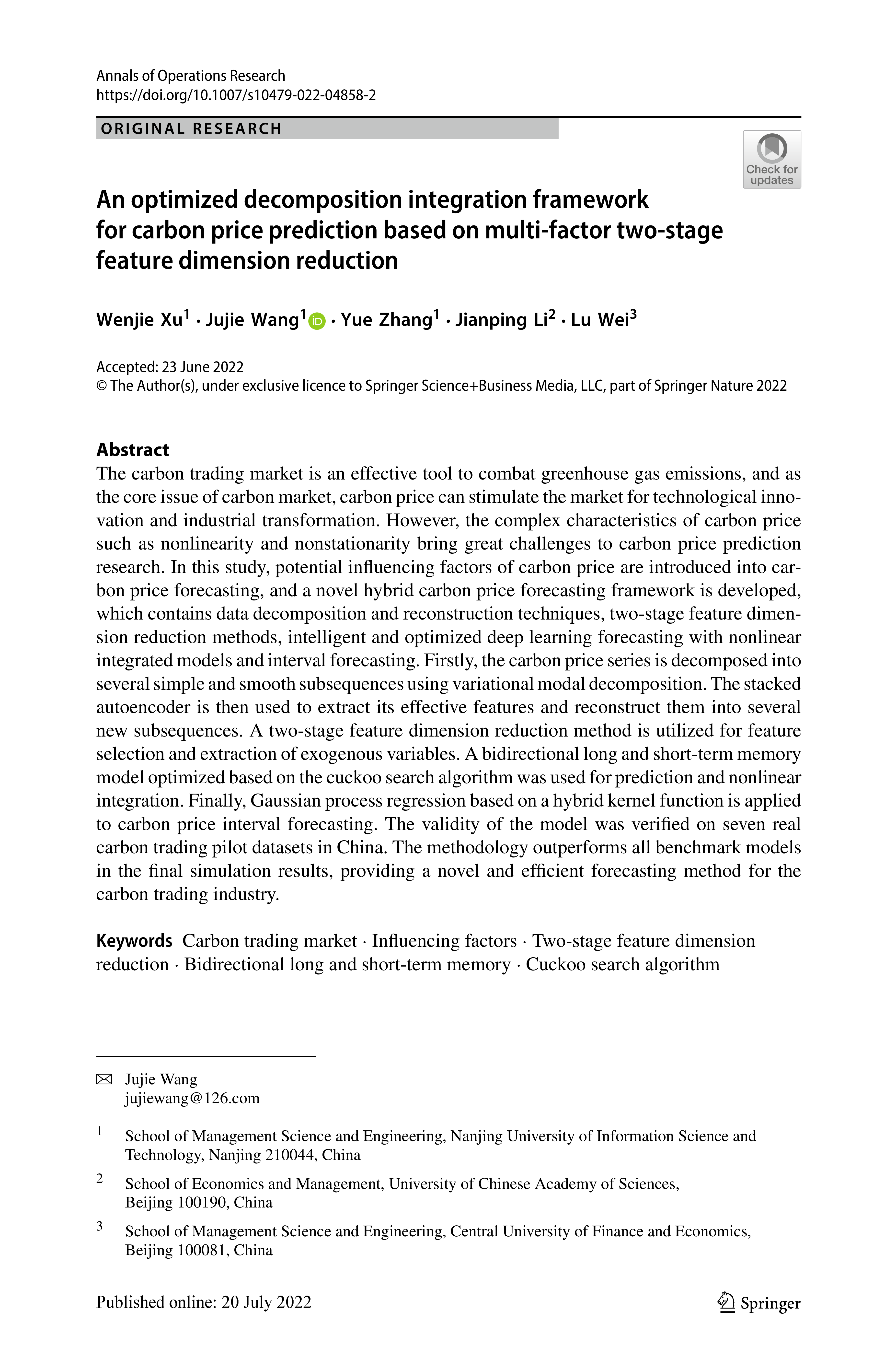 An Optimized Decomposition Integration Framework for Carbon Price Prediction Based on Multi-Factor Two-Stage Feature Dimension ReductionWenjie Xu, Jujie Wang*, Yue Zhang, Jianping Li, and Lu WeiAnnals of Operations Research, Jul 2022
An Optimized Decomposition Integration Framework for Carbon Price Prediction Based on Multi-Factor Two-Stage Feature Dimension ReductionWenjie Xu, Jujie Wang*, Yue Zhang, Jianping Li, and Lu WeiAnnals of Operations Research, Jul 2022The carbon trading market is an effective tool to combat greenhouse gas emissions, and as the core issue of carbon market, carbon price can stimulate the market for technological innovation and industrial transformation. However, the complex characteristics of carbon price such as nonlinearity and nonstationarity bring great challenges to carbon price prediction research. In this study, potential influencing factors of carbon price are introduced into carbon price forecasting, and a novel hybrid carbon price forecasting framework is developed, which contains data decomposition and reconstruction techniques, two-stage feature dimension reduction methods, intelligent and optimized deep learning forecasting with nonlinear integrated models and interval forecasting. Firstly, the carbon price series is decomposed into several simple and smooth subsequences using variational modal decomposition. The stacked autoencoder is then used to extract its effective features and reconstruct them into several new subsequences. A two-stage feature dimension reduction method is utilized for feature selection and extraction of exogenous variables. A bidirectional long and short-term memory model optimized based on the cuckoo search algorithm was used for prediction and nonlinear integration. Finally, Gaussian process regression based on a hybrid kernel function is applied to carbon price interval forecasting. The validity of the model was verified on seven real carbon trading pilot datasets in China. The methodology outperforms all benchmark models in the final simulation results, providing a novel and efficient forecasting method for the carbon trading industry.
@article{xuOptimizedDecompositionIntegration2022, title = {An Optimized Decomposition Integration Framework for Carbon Price Prediction Based on Multi-Factor Two-Stage Feature Dimension Reduction}, shorttitle = {基于多因素两阶段特征降维的碳价格预测优化分解集成 框架}, author = {Xu, Wenjie and Wang, Jujie and Zhang, Yue and Li, Jianping and Wei, Lu}, year = {2022}, month = jul, journal = {Annals of Operations Research}, issn = {0254-5330, 1572-9338}, doi = {10.1007/s10479-022-04858-2}, langid = {english}, dimensions = {true}, gscholar = {true}, }